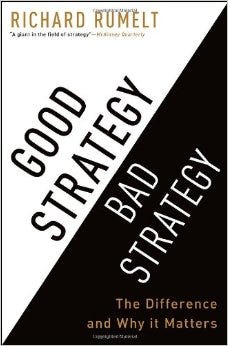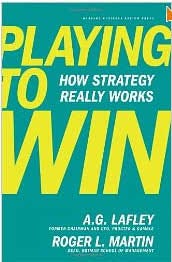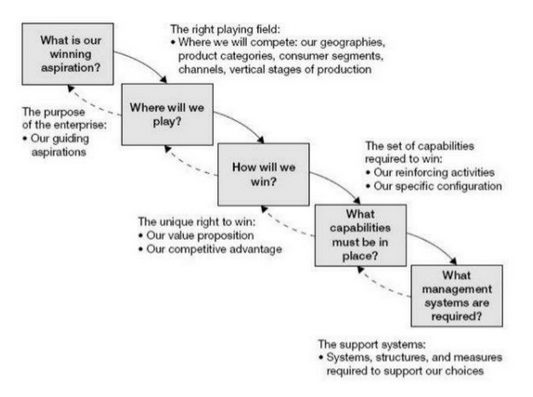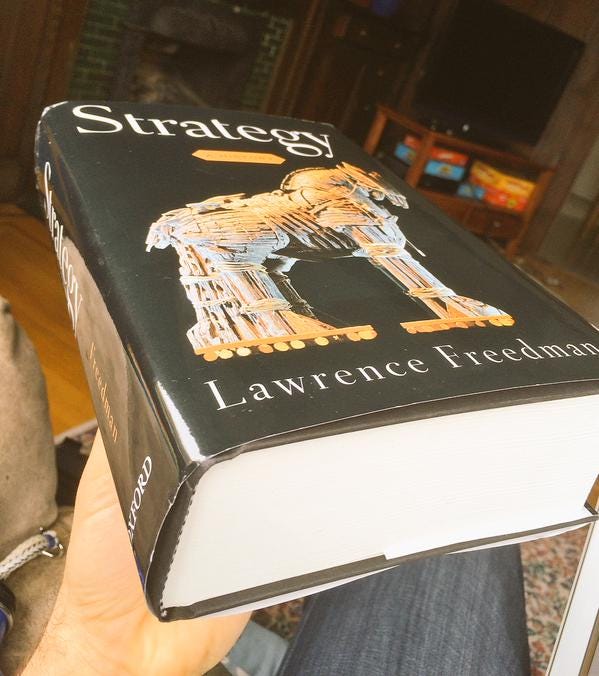How to Master the Craft of Strategy — Why One Decision can Make your Company and How to Get it…
Evergreen is a weekly collection of links to the best learning resources in business, collected by a group of managers, founders, and investors. We contribute resources about one topic each week, which are synthesized and shared in this Weekly Edition. The aim is to learn more efficiently through increased context and focus. Join here to receive the next Edition of Evergreen Business Weekly.
Remember, these are designed to feel like short books, you’re meant to meander and spend ~3 hours on this topic this week. Save some of these links and read them throughout the week. Immerse yourself in this topic and leave the week smarter than you started it!
Oh man, I’m so excited for this Edition. I distinctly remember the first moment I got a loose grasp on Business Strategy, and it was instantly illuminating. Getting the basics of strategy ingrained will have you seeing the world differently.
We’ll start by taking a look at the core of Strategy, the basics that are applicable for any business, with frameworks that you can use immediately. To dive deeper, we’ll see some different ways to think about Strategy that will give you completely new perspectives on your company.
Strategy 101 — Definition and Basics
Among all of the possible definitions of Business Strategy, this set of points(from Ray Stern) seem the most precise and descriptive. Read it slow:
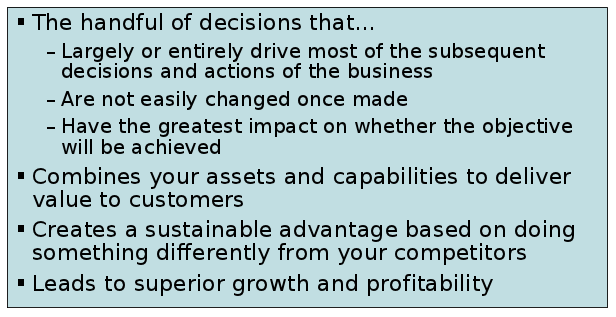
Ray was kind enough to share a deck that he made for internal training during his tenure at Intuit. It’s a fantastic resource and you’ll see more from it shortly.
Know enough to be Dangerous
If you only read one thing in this post — it should be this section, about the book by Richard Rumelt: Good Strategy, Bad Strategy. This was the first book that really made strategy accessible to me.
Rumelt describes Bad Strategy, which probably sounds familiar to you:
Bad strategy is not simply the absence of good strategy. It grows out of specific misconceptions and leadership dysfunctions. Once you develop the ability to detect bad strategy, you will dramatically improve your effectiveness at judging, influencing, and creating strategy. To detect a bad strategy, look for one or more of it’s four major hallmarks:
Fluff: Fluff is a form of gibberish masquerading as strategic concepts or arguments. It uses “Sunday” words (words that are inflated and unnecessarily abstruse) and apparently esoteric concepts to create the illusion of high-level thinking.
Failure to face the challenge: Bad strategy fails to recognize or define the challenge. When you cannot define the challenge, you cannot evaluate a strategy or improve it.
Mistaking goals for strategy: Many bad strategies are just statements of desire rather than plans for overcoming obstacles.
Bad strategic objectives: A strategic objective is set by a leader as a means to an end. Strategic objectives are “bad” when they fail to address critical issues or when they are impracticable.
[…]
Not miscalculation, bad strategy is the active avoidance of the hard work of crafting a good strategy. One common reason for choosing avoidance is the pain or difficulty of choice. When leaders are unwilling or unable to make choices among competing values and parties, bad strategy is the consequence.
If this describes your company, you better go look for a new job, or roll up your sleeves and get to work.
Now here are the details for good strategy:
Good strategy is coherent action backed up by an argument, and effective mixture of thought and action with a basic underlying structure I call the kernel. A good strategy may consist of more than the kernel, but if the kernel is absent or misshapen, then there is a serious problem. Once you apprehend this kernel, it is much easier to create, describe, and evaluate strategy.
The kernel is not based on any one concept of advantage. It does not require one to sort through legalistic gibberish about the differences between visions, missions, goals, strategies, objectives, and tactics. It does not split strategies into corporate, business, and product levels. It is very straightforward.
The kernel of a strategy contains three elements:
A Diagnosis that defines or explains the nature of the challenge. A good diagnosis simplifies that often overwhelming complexity of reality by identifying certain aspects of the situation as critical.
A Guiding Policy for dealing with the challenge. This is an overall approach chosen to cope with or overcome the obstacles identified in the diagnosis.
A set of Coherent Actions that are designed to carry out the guiding policy. These are the steps that are coordinated with one another to work together in accomplishing the guiding policy.
If you understand the definition of strategy and these two explanations well enough, you know enough strategy to make an impact today.
This book is the perfect place to start learning about strategy. The approach of codifying and explaining bad strategy alone makes this a crucial read. Avoid the traps of bad strategy, and you’re likely to do fine.
If you’re more of a video/audio person, this lecture by author Richard Rumelt at the London School of Economics is fantastic.
Good Strategy, Bad Strategy and this video were also suggested by Graham Moody of Ansarada, who has had Richard Rumelt speak to their company.
Meg Whitman’s Favorite Book (CEO of Ebay & HP)
When Zaarly, the startup I’ve been working on for the past few years, was transitioning into a new business model, we got some advice from our board member Meg Whitman, former CEO of Ebay and current CEO of Hewlett Packard. She recommended we go buy copies of Playing to Win for our team, and use that framework to refine our strategy.
Co-Authored by the Dean of Rotman school of Management and AG Lafley, former Chairman and CEO of Proctor & Gamble, it blends two approaches to strategic thinking: stories from the trenches and theories from Academia.
The core of the book introduces the framework that P&G has used countless times to create successful brands, products, and new product categories.
A strategy is a coordinated and integrated set of five choices:
– A winning aspiration
– Where to play
– How to win
– Core Capabilities
– Management systems
Here it is in graphic form with some additional notes:
Each of these decisions must respect the others — they are not made independently. Together they form a playbook and create the focus that will unite a team‘s efforts.
This is a great book for a company currently navigating some strategic challenges. Sitting down to answer these questions with some of the book’s examples fresh in mind can create breakthrough ideas.
The Opposite of your Strategy must be a Strategy
One simple and powerful test of your strategy is that the opposite must also be a reasonable strategy. Otherwise, you haven’t made any actual decisions at all, you’ve just stated the obvious.
This is what Erik Martin, former GM of Reddit, had to say:
“Execute well” is not a strategy because no business would willingly say that their strategy is to “Execute poorly”. Whereas “focus on local markets” is a strategy because the same business could reasonably choose to “focus on national markets”. Strategy has to be a choice between viable options.
This short post from Roger Martin on Harvard Business Review goes into a little more detail on this test, and has some stunning examples:
The senior team of a large player in the global wealth management business recently asked me for my opinion on their strategy. They had worked long and hard at coming up with it. Their “Where to Play” choice was to target wealthy individuals who wanted and were willing to pay for comprehensive wealth management services. Their “How to Win” choice was to provide great customer service across the breadth of their wealth management needs. I pushed and probed, but that was it.
Sadly, like the majority of strategies that I read, this firm’s strategy failed my sniff test and for that reason I would bet overwhelmingly that it will fail in the market as well. The test I apply is quite simple. I look at the core strategy choices and ask myself if I could make the opposite choice without looking stupid. For my wealth managers, the opposite of their “where” choice was to target poor individuals who don’t want and aren’t willing to pay for comprehensive wealth management services. The opposite of their “how” is to provide crappy customer service.
The point is this: If the opposite of your core strategy choices looks stupid, then every competitor is going to have more or less the exact same strategy as you.
If you’re thinking “Yea, Duh.” I’m right there with you, but it happens every day. Just don’t let it be you.
Strategy is what creates Competitive Advantage
If there is a prerequisite for understanding Strategy, it’s understanding Competitive Advantage. Strategy is how we create a Competitive Advantage, how to make the decisions we make that get us closer to the destination.
To understand Competitive Advantage, check out the Edition of Evergreen on it, How to Create a Winning Business, which includes wisdom from Peter Thiel, Warren Buffett, and Sam Walton. Also, the classic from Michael Porter, The Five Competitive Forces that Shape Strategy.
Peter Thiel’s lecture at Stanford, Competition is for Losers, was suggested by Victor Sowers, and has some great thoughts on how competitive advantage creates monopolies.
More Perspectives on Strategy
There are a lot of emerging opinions on Strategy, and new ways to think about it. There are examples and metaphors from nearly every discipline, all fascinating in their own way.
Center vs. Periphery Strategy
One interesting pattern that came up was the flow of new ideas from the periphery to the center. This post from the archive of BCG has an excerpt that captures this concept well:
Strategy requires regular visits to the periphery in order to explore and learn. The periphery is the realm of opportunities that an organization has not yet discovered. It is a vast greenfield in which modest and prudent investments can produce huge payoffs for the center.
Structurally, those investments can take a variety of forms — the purchase of promising new start-ups, the funding of skunkworks completely separated from the center, the establishment of competing development teams, the hiring of experts from the periphery. The key for organizations at both the center and the periphery is to calculate the costs of bridging the distance between the two poles.
Strategy is a continuous movement between new centers and new peripheral businesses. As the history of great innovators such as Apple, Google, and Microsoft demonstrates, a business might begin at the periphery and, as it increasingly enjoys success, end up at the center. Then, once it occupies the center, it will soon face new competitors at its periphery.
This model shows us the rise and fall of companies in many industries, and it’s a narrative that dominates strategy, especially in innovative sectors. It also explains why companies in the center are so determined to tame or defend themselves from the periphery.

Jeff Bezos has an amazing quote about this strategy in this fantastic interview with Henry Blodget. Thanks to Mike Smith for the contribution!
I’ve made billions of dollars of failures at Amazon. Literally billions of dollars of failures. You might remember Pets.com or Kosmo. It was like getting a root canal with no anesthesia. None of those things are fun. But they also don’t matter.
What really matters is, companies that don’t continue to experiment, companies that don’t embrace failure, they eventually get in a desperate position where the only thing they can do is a Hail Mary bet at the very end of their corporate existence. Whereas companies that are making bets all along, even big bets, but not bet-the-company bets, prevail. I don’t believe in bet-the-company bets. That’s when you’re desperate. That’s the last thing you can do.
This also bears an interesting relationship to the classic concept from Clayton Christensen, The Innovator’s Dilemma. Defending the center is not impossible, but it’s extremely hard over time. This short video explains the concept, and how the theory can be translated to all businesses.
Thanks to Ray Stern for suggesting this video, and directing me to the BCG archive, which was full of good stuff.
Emergent Strategy
This incredible post on Harvard Business Review, called Crafting Strategy makes the important distinction between strategic planning and execution, and proposes that the two should be iterative and intertwined.
Virtually everything that has been written about strategy making depicts it as a deliberate process. First we think, then we act. We formulate, then we implement. The progression seems so perfectly sensible. Why would anybody want to proceed differently?
My point is simple, deceptively simple: strategies can form as well as be formulated. A realized strategy can emerge in response to an evolving situation, or it can be brought about deliberately, through a process of formulation followed by implementation.
While it is certainly true that many intended strategies are ill conceived, I believe that the problem often lies one step beyond, in the distinction we make between formulation and implementation, the common assumption that thought must be independent of (and precede) action. Sure, people could be smarter — but not only by conceiving more clever strategies. Sometimes they can be smarter by allowing their strategies to develop gradually, through the organization’s actions and experiences. Smart strategists appreciate that they cannot always be smart enough to think through everything in advance.
Crafting Strategy is a beautifully-written series of thoughts on including execution, testing, and iteration into your strategic thinking. This post is a great balance to the frameworks we’ve been looking at so far.
“However beautiful the strategy, you should sometimes look at the results”
— Winston Churchill
A huge thank-you to Kenny Fraser for suggesting Crafting Strategy.
Strategy is Context-dependent & Ever-changing
All decisions are dependent on their environment. Obvious as it may seem, it’s always worth remembering that both ‘turn right’ and ‘turn left’ are either correct or deadly depending on the situation. Strategic decisions share this trait, as John Hagel explores in his blog, Edge Perspectives.
He makes a distinction between ‘Terrain Strategy’ in which you can see where you’re going and navigate toward it, and ‘Trajectory Strategy’ when things move far too quickly to navigate in real-time and the only way to win is to anticipate correctly.
If we just focus on position in the current landscape, we risk being blindsided as the landscape rapidly evolves into something quite different. What looks like solid high ground today can quickly become quicksand, dragging us under.
Perhaps even more importantly, the most advantaged locations in the future landscape often are not even part of today’s landscape and they will tend to emerge and be shaped by significant economies of scale and network effects that will play out very quickly once critical mass has been achieved. Playing a wait-and-see game in the hope that things will become clearer over time can be very dangerous. By the time you see what’s happening, it may be too late to do anything about it. Fast followers in an exponential world will increasingly find that they are on a path to the grave.
Most strategies (strategies of terrain) tend to look from the present out to the future. Strategies of trajectory start with a view of the future and work back to the implications for action in the present.
Here’s the paradox: strategies of trajectory become more and more essential in times of rapid change and uncertainty, while at the same time becoming more and more difficult.
This set of two blog posts, The Big Shift in Strategy, Part 1 and Part 2 are quick reads with great insight. Thanks to Matt Frost of Medallia for suggesting these posts and this new perspective.
What we can learn from the History of Strategy
In Strategy, timeless principles unfold in an ever-evolving modern arena. History is full of lessons that apply to the challenges of today.
There’s a massive amount to learn from the successes and failures of the strategic decisions in our past, as seen in this massive book on the history of Strategy, suggested by Erik Martin.
I’m only a few pages in (out of 600+), and it’s already extremely interesting. Freedman talks about how base strategy is to our nature, and how primates demonstrate strategic thinking for mating and social maneuvers. To learn the lessons of the history of strategy, there’s nothing more comprehensive than Strategy, a History.
Reading Lists for Future Strategy Masters
There’s always another vital lesson out there. The next page might hold the secret to building your business or preventing your next disaster. To keep learning more about strategy, here are two great reading lists that will be instructive in complementary ways.
Harvard Business Review’s 10 Must-reads on Strategy. The best 10 case studies, papers and posts over the past few decades from the most prestigious business school on earth. There’s gold in these pages.
Thanks to Bo Fishback for finding and suggesting this set of papers!
Ryan Holiday’s reading list on Strategy, 24 Books to Hone Your Strategic Mind. An interesting mix of philosophy, military history, and political lessons, this looks like a fascinating blend of perspectives with the promise of insights that will change the set of possibilities you perceive.
Thanks to Aaron Wolfson for contributing this list, and Ryan Holiday for putting it together.
If you enjoyed this, you’ll get more like it by joining Evergreen:
My Other Projects
Upcoming Book: The Almanack of Naval Ravikant
Evergreen Lives on Donations
Creating Evergreen takes a lot of time and decent amount of money. If you find anything helpful and interesting here, please consider buying me some BBQ ($11 Z-Man & Fries at Joe’s KC), or really anything between a coffee and a good dinner. Thank you very much! ❤ ☺Thank you
Massive appreciation for who suggested pieces of content (or wrote something new) for this Edition of Evergreen: Ray Stern, Aaron Wolfson, Bo Fishback, Matt Frost, Erik Martin, Victor Sowers, Graham Moody, Kenny Fraser, Derek Baynton, Itamar Goldminz, Julian Miller, and a special thank-you to Mike Smith, who bought and donated the domain Evergreenlibrary.com to the cause. Thank you Mike!
Many thanks for being a part of this project! Not every suggestion is able to make it to the final edit, but every single suggestion is read and appreciated.
Never Enough
As my Father always says: “There’s always room for the best.” There’s always a better resource out there. These collections can always get better, and I hope that they do. If you can think of anything that was missed, I welcome you to share it.
To share your thoughts, improvements or additions: Email or Twitter.
If you liked this, check out other Editions of Evergreen:
Building and Managing a Team:
How to Find and Recruit the Team you Need
How Not to Hire like a Clownshow
Compensation Rules Everything Around Me
Why Employee Onboarding is holding you back
How to Boost Employee Retention
How Performance Reviews are being Reinvented
Secrets to Perfecting Organizational Communication
How to Manage Scale, and Operate in Scaling Organizations
How to Fire an Employee
What you actually need to know about Company Culture
How to Interview Prospective Hires
Strategy and Competitive Advantage:
How to Master the Craft of Strategy
Competitive Advantage: How to Build a Winning Business
The Power of Network Effects
How Cost Leadership Builds Powerful Businesses
Why the Best Brands Stand Out
Scale as Competitive Advantage
Barriers to Entry are Confusing
Flywheel Effect: Meta-Competitive Advantage
Building the Business:
How to be a Great Human:
How to Start a New Job: Handling Career Transitions like a Boss
How to Master the Discipline of Product Management
The Ancient Origins of Storytelling, and how to Apply Them
I've also written about How & Why we started Evergreen:
How a prototype's failure created the next iteration
Mission & Method of Evergreen
Follow me on Twitter: @EricJorgenson
And Please... Join Evergreen.


